What do radiologists look for? Advances and limitations of perceptual learning in radiologic search
- PMID: 33057623
- PMCID: PMC7571277
- DOI: 10.1167/jov.20.10.17
What do radiologists look for? Advances and limitations of perceptual learning in radiologic search
Abstract
Supported by guidance from training during residency programs, radiologists learn clinically relevant visual features by viewing thousands of medical images. Yet the precise visual features that expert radiologists use in their clinical practice remain unknown. Identifying such features would allow the development of perceptual learning training methods targeted to the optimization of radiology training and the reduction of medical error. Here we review attempts to bridge current gaps in understanding with a focus on computational saliency models that characterize and predict gaze behavior in radiologists. There have been great strides toward the accurate prediction of relevant medical information within images, thereby facilitating the development of novel computer-aided detection and diagnostic tools. In some cases, computational models have achieved equivalent sensitivity to that of radiologists, suggesting that we may be close to identifying the underlying visual representations that radiologists use. However, because the relevant bottom-up features vary across task context and imaging modalities, it will also be necessary to identify relevant top-down factors before perceptual expertise in radiology can be fully understood. Progress along these dimensions will improve the tools available for educating new generations of radiologists, and aid in the detection of medically relevant information, ultimately improving patient health.
Figures


References
-
- Alzubaidi M., Balasubramanian V., Patel A., Panchanathan S., & Black Jr J. A. (2010, March). What catches a radiologist's eye? A comprehensive comparison of feature types for saliency prediction. In Medical Imaging 2010: Computer-Aided Diagnosis. International Society for Optics and Photonics, 7624, 76240W, doi:10.1016/j.visres.2011.12.004. - DOI
Publication types
MeSH terms
Grants and funding
LinkOut - more resources
Full Text Sources

